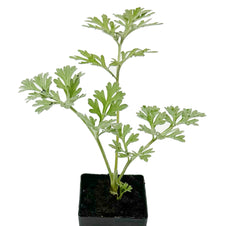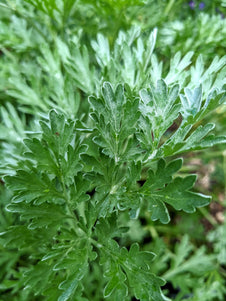





Wormwood
Wormwood

- In stock, ready to ship
- Inventory on the way

Usually available: All year
Life cycle: Perennial
Height: 80cm - 1.2m
Position: Full sun
Soil preference: Well drained
This is how we pack and send your Herb Plants to all states except TAS & WA
You will receive
- 1 Wormwood Herb Plant in a 50 X 75mm tube - General growing instructions
All of our Herb Plants are grown organically with certified organic potting mixes and fertilizers
Botanical Name: Artemisia absinthium
Wormwood is an aromatic, herbaceous perennial growing from 80cm to 1.2 meters. Rarely, the tall branching stems will reach 1.5 meters. The stems extend from the perennial roots and can be quite woody at the base. The stems are quite strong and are also white-silver toned, due to the coverage of many small hairs. The leaves are up to 8cm by 3 cm, divided into segments and arranged in a spiral around the grooved stem. The deeply serrated leaves are greyish green above and white on the underside, with both sides covered in fine silky trichomes or oil producing hairs. The overall appearance is a generally grey or silvery toned plant. The flowers are small, globular and a yellow-green colour. The pendulous flowers are held in an erect leafy panicle and bloom in summer.
There are several species of wormwood which have slightly different characteristics. Although there is a strong history of using wormwood for many different purposes, many people grow it today for its ornamental attributes.
Wormwood is known to be very bitter in taste, second only to rue, which inspired the Ancients to have a saying ‘as bitter as wormwood’. In traditional folklore, wormwood was seen to be an old love charm when combined with marigold, thyme and marjoram. The Ancients also said that wormwood counteracted the effects of hemlock and toadstool poisoning, as well as the ‘biting of the sea dragon’. Wormwood is a highly valued herb for ritualistic practices and historically it was seen as powerful in warding off demons. Both wormwood and mugwort had many similar uses, but only wormwood has a strong essential oil.
The name Artemisia is from Ancient Greek used in Hellenistic cultures, where the Goddess Artemis was the goddess of the hunt, protector of the forest and children. The term wormwood is from the Middle English wormwode or wermode, which was attributed to the plants antihelminthic attributes in helping to expel worms from the body. The species name ‘absinthium’ is thought to be derived from ‘absinthe’, an approximation of the ancient Greek word for wormwood. There is also a common explanation that the word ‘absinthe’ means ‘undrinkable’, a reference to the bitter taste. However, this term may have been borrowed from Persia as a link to the name of another bitter herb called Syrian Rue, which is not related to the common rue plant.
The native habitat of Artemisia absinthium is generally dry to temperate regions of the world, with low quality soils. It is found throughout much of Europe and Siberia, so extreme cold is not a deterrent. In Great Britain, wormwood is thought to be truly native near coastal areas and several inland locations in Britain and Scotland. It may have also been native to Ireland, but may have been transported there very early in recorded history. Wormwood has naturalized in the United States and Canada, but is so bitter that it is not useful as forage for any animals. It has been cultivated in many regions of the world due to its many useful attributes.
Growing Conditions
Wormwood is often found in uncultivated or waste ground and near footpaths or roadsides. It prefers rocky slopes and arid ground in nature, so dry gardens are ideal for wormwood. This plant does well in poor soils, but does prefer nitrogen rich soil where possible. Soil should be well drained and not too heavy. Wormwood is good for dry areas, but water is summer will be welcomed. There is a good chance it will do well in part shade and sunny spots, since both are recommended by gardeners.
The roots are perennial and generally survive cold winters, even if the leafy stems die down or succumb to frost. Propagation is by division, by taking cuttings or by sowing seed in autumn. Wormwood will also self-seed if allowed to. Plants may also be divided every 2-3 years to maintain plant quality and vigor by removing the centre of the plant. Wormwood is a hardy plant and should require little maintenance beyond trimming to encourage a bushy growth habit.
Medicinal Uses
Medicinal use of wormwood dates back to Ancient Egypt and wormwood flavoured wine was dated to Ancient Greece. Egyptian papyrus scrolls show that as early as 1552, wormwood was used as a tonic and for various ailments, such as rheumatism. ‘Modern’ use of wormwood dates to the 18th century when a specific recipe was patented and sold as a medicinal elixir. The chemical constituents of A. absinthium include thujone, azeulenes which are anti-inflammatory, and sesquiterpene lactones.
As with many herbs there was a wide range of traditional medicinal applications for wormwood. However, it was very well known for its treatment and prevention of intestinal worm infestation. Another popular use was to bring on late menstrual cycles, which indicate restrictions on use for pregnant and breast feeding women. Similar uses were observed for mugwort and there is a similar contradiction is the use of these plants to ease the pain of women in labour.
Other uses included treating many digestive ailments because the chemicals in the plant increase the peristaltic action of the intestinal tract. It was considered good for people suffering from ‘jamming of the gut’ and ‘lethargic digestion’ because wormwood helped ‘move things along’. It was also suggested to improve appetite, help enzyme activity, and be an excellent energizer. Wormwood also treated flu, colds and coughs, and fever. Wormwood may be soaked in a tea infusion and used to make a compress for bruises and bites.
Wormwood should not be consumed for long periods due to the possible toxicity of the plant. It is better to use dried or fresh herb, since the concentrated essential oils will be very strong extracts and they should be used sparingly. Symptoms of toxicity include dizziness, nausea, vomiting, insomnia, restlessness, spasms and convulsions, foaming at mouth and other neurotoxic signs.
A wormwood tea infusion may be made by taking 2 cups of boiling water, removed from heat, and adding 4 teaspoons of dried leaves and flowers. Cover and allow the wormwood to steep, and then drink on an empty stomach 3 times per day. Maple syrup or mint may be added to assist with the bitter taste.
Culinary Uses
Wormwood (A. absinthium) is extensively cultivated and has been known for its use in several alcoholic drinks, notably Vermouth and Absinthe. In Vermouth, wormwood flower heads were one of several traditional ingredients mixed with strong alcohol. The name vermouth was taken from the German ‘wermut’ for wormwood.
The drink Absinthe has a controversial history due to a ban being placed on the drink (on wormwood in drinks) in many countries in the early 20th Century. The ban was due to the perceived hallucinatory effects of the chemical thujone, contained within the wormwood plant. This was later proved to be incorrect and may have been attributable to the interactions of other ingredients. It must also be remembered that the alcohol content of Absinthe was generally much higher than normal alcoholic drinks.
The drink was featured in the movie Moulin Rouge and has become popular again, but the production process and the quality may be variable. Although the ban on use of wormwood has been eased in many regions the traditional process is more time consuming and costly. Some countries in Europe still make Absinthe in the traditional manner, but most brands rely on artificial essences and colours added to strong alcohol. The traditional green colour of Absinthe is from the chlorophyll obtained from using fresh wormwood plants.
Other Uses
Wormwood is known to be a good insecticide and insect repellent due to the presence of both thujone and sesquiterpene lactones. To use wormwood as a personal insect repellent, mash a small quantity of leaves until moist and mix with a small amount of apple cider vinegar. Place this mixture in a small cloth (or cloth bag) and tie the corners. Use the damp cloth to wipe the mixture over arms and legs as needed when outdoors.
Alternatively, to make a wormwood moth bag mix one cup each of dried wormwood, spearmint, tansy, and thyme with four cinnamon sticks. Place in a small cloth bag and hang/keep wherever moths are a problem.
All information provided on this website is for informational purposes only. Please seek professional advice before commencing any treatment.





